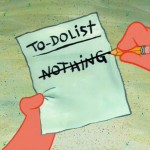 A big focus on what I talk about is the natural learning path for right-brained children. In my book, The Right Side of Normal, Section Three has chapters on all the major school subjects that share how a right-brained child typically learns that subject, from the early stages to the later stages. I was doing something for each subject at each age. It’s just that right-brained children need a different set of resources and a different kind of focus than you see in the left-brained focused school system.
A big focus on what I talk about is the natural learning path for right-brained children. In my book, The Right Side of Normal, Section Three has chapters on all the major school subjects that share how a right-brained child typically learns that subject, from the early stages to the later stages. I was doing something for each subject at each age. It’s just that right-brained children need a different set of resources and a different kind of focus than you see in the left-brained focused school system.
I found these great quotes that I will use as fodder to share some of the things my right-brained children were focused on:
A people without the knowledge of their past history, origin and culture is like a tree without roots. ~Marcus Garvey
Right-brained learners crave knowing why. History is a perfect subject to figure out why and how people lived in the past, and how that relates to today. My children loved hearing stories of their ancestors and how that makes them who 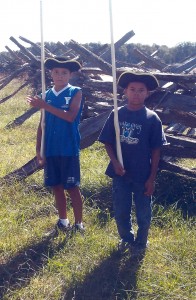 they are today, and how they can live today to reflect their heritage. It’s common for right-brained children to enjoy the ancient histories. Why did the people act the way they did? Why did they inter-relate in the way they did? Do we see in ourselves today what we see in those in long ago times?
they are today, and how they can live today to reflect their heritage. It’s common for right-brained children to enjoy the ancient histories. Why did the people act the way they did? Why did they inter-relate in the way they did? Do we see in ourselves today what we see in those in long ago times?
So, first, in the early grades, my right-brained children were very interested in knowing why events and ideas happened in history and how it relates to them today. Later, they found it interesting to see how the dates fell into the grand historical scheme of things.
Reading, after a certain age, diverts the mind too much from its creative pursuits. Any man who reads too much and uses his own brain too little falls into lazy habits of thinking. ~Albert Einstein
A truly good book teaches me better than to read it. I must soon lay it down, and commence living on its hint. What I began by reading, I must finish by acting. ~Henry David Thoreau
I discussed in my last post how my children viewed books. As these quotes say, books were their resource and catalyst for thinking and creating. It was not the end to learning, but the beginning. Thus, though some of my right-brained children didn’t learn to read until later, books were still most definitely a resource used to inspire and be a jumping point. Maybe, just maybe, later reading actually encourages more independent thinking skills, as Einstein implies. And creativity, innovation, and imagination are at the heart of a right-brained person’s universal gifts.
So, first in the early grades, books are understood to be sources of inspiration, creativity and imagination. As long as a rich source of print materials are available to non-readers, books are still very much an important resource. Later reading acquisition then enhances their foundation of free thinking.
You want a lesson? I’ll give you a lesson. How about a geography lesson? My father’s from Puerto Rico. My mother’s from El Salvador. And neither one of those is Mexico. ~Jennifer Esposito
From my book, Chapter 20:
I remember teaching my artist son about maps when he was around 5 years old. I figured he could make a map of our neighborhood, since that’s what one starts with at this age, right? As usual, he asked more questions about the task and discovered that his neighborhood was in a city. On our city map, we looked up the location of our neighborhood. He wanted to go farther. Out came the state map on which we found our city. We looked at the map of the United States, then North America. (Oh, how he would have loved Google Earth™ if it had existed!). As he let this information percolate, a few hours later he stated, “So, if I was standing on the map of our city, I would be this big.” He held up his fingers to a small entity. He continued, “And if I was standing on a state map, I would be this big.” He shortened the height. “And if I was standing on a country map, I would be a tiny dot. And if I was standing on the continent map, I would be so little, you would need a microscope to see me. And if I was standing on the map of the solar system, I would be smaller than a germ.” Wow! That was deep, I 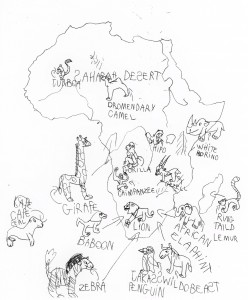 thought. It all began with introducing the idea of maps using our neighborhood, like any other kindergarten curriculum.
thought. It all began with introducing the idea of maps using our neighborhood, like any other kindergarten curriculum.
So, a right-brained child isn’t the type of learner who simply looks to label. He wants to know how he relates to his world. He wants to know who lives in Japan. He wants to know how the Africans live. He wants to know what animals live in the rainforest of South America. Again, later, labeling and knowing all the countries or capitols take on more meaning when they have the back story.
If you do not breathe through writing, if you do not cry out in writing, or sing in writing, then don’t write, because our culture has no use for it. ~Anais Nin
The mechanics of writing sentence or paragraph structures is the skills of writing. But to be a writer, one must have something important to write about. And then a writer must have confidence in the voice she writes in. I did very well in school as I was taught explicitly the skills of writing, but I never considered myself a writer. It took finding my passion in different ways children learn to find something passionate to write about. But it’s still a struggle for me to feel I have a competent voice when I write. I find that I often revert back to sterile mechanics. When we read writing like that shared in the above Nin quote, we’re changed.
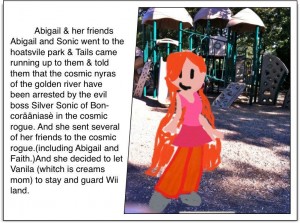 So, first, my right-brained children shared their stories, which developed their natural voice. They did this through drawings, oral storytelling, conversation, sharing dreams, movie making, comic book making, and other self-created books. They learned in the telling what interested their audience and what was exciting to them to relate. Later, the mechanics were added to their voice and original stories to create competent and confident writers.
So, first, my right-brained children shared their stories, which developed their natural voice. They did this through drawings, oral storytelling, conversation, sharing dreams, movie making, comic book making, and other self-created books. They learned in the telling what interested their audience and what was exciting to them to relate. Later, the mechanics were added to their voice and original stories to create competent and confident writers.
I think it’s fair to say that personal computers have become the most empowering tool we’ve ever created. They’re tools of communication, they’re tools of creativity, and they can be shaped by their user. ~Bill Gates
I don’t understand why the use of computers isn’t more prolific in the learning lives of children. Like the television, every household now has multiple computers in their homes. The internet can be accessed anywhere you are in the world: from your home, your work, your car, or on the streets. And yet, children go to computer labs weekly? An hour a day? My children access the computer and what it offers throughout their learning day, for various reasons. Bill Gates is certainly right when he said it’s probably the most powerful tool ever created.  And the most under-utilized in our schools!
And the most under-utilized in our schools!
Certainly I’m aware and careful of the effects of too much screen time on children, especially young children, but it’s also a powerful tool for learning that can’t be ignored. My younger children played educational games in the early years and quickly learned to use Google and You Tube (thus, a reason for spelling). Coloring pages and printed pictures were used to enhance storytelling. Later, movie-making tools, sharing with the world, and programming were added.
My main concern with the condition of mathematics in high school is that there’s a lot of fear involved! Math is not, generally speaking, presented in a fun way. The concepts, as I see them, are fun, and that’s the way I’d like to convey them myself. ~Danica McKellar
Now, admittedly, I found arithmetic fun as a left-brained learner. But, I don’t think we become mathematicians; I think we become number manipulators. It’s not the same thing. Math is actually all about concepts, patterns, and how it all relates to the world around us. Math minds can see this. We teach number manipulation in school, not the beauty of patterns and math ideas. Math is about thinking. It’s a lot like science. There needs to be exploration and examination. That makes it messy, unlike rows of easily corrected math problems.
My young children explored with math manipulatives, mental math tricks, and visual math concepts through great resources such as those found here. We talked about the math going on all around us. I talked about how I looked at numbers when I shopped for anything by comparing prices, when I cooked, and when I was doing home improvements. Later, arithmetic could be taught in a matter of a couple of years because it made more sense against the backdrop of conceptual knowledge of its purpose.
A fact is a simple statement that everyone believes. It is innocent, unless found guilty. A hypothesis is a novel suggestion that no one wants to believe. It is guilty, until found effective. ~Edward Teller
This is the scientific process. We only know the Truth based on how much we’ve uncovered today. But tomorrow, all the Truths can be disproved and new Truths prevail. This is actually even true of the left- and right-brained theories of learning. First, it was the greatest discovery since sliced bread. Different parts of the brain specialize in various skills. Over time, as more questions were asked and more technology made available, new theories are considered. Science is the 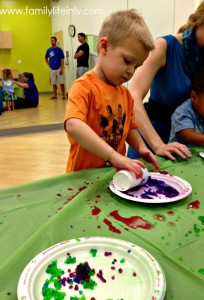 quest for knowledge. Science uses creativity, innovation, and imagination. These are traits right down the alley of right-brained learners.
quest for knowledge. Science uses creativity, innovation, and imagination. These are traits right down the alley of right-brained learners.
When younger, my right-brained children enjoyed doing nature studies, animal behavior studies, and experiments. Again, they wanted to know the why and how while they were young. It was intriguing to them. It piqued their curiosity. They are natural questioners and theory creators. Figuring out the vocabulary or labels in context were much more likely to end up in long-term memory, the preferred memory path for right-brained learners.
My children are engaged in learning. Your children would be engaged in learning outside of the left-brained scope and sequence. In the young years, learning is centered in their foundational gifts…their strengths…through play. For right-brained children, the creative outlets is a central theme of learning expression. Section Three of my book showcases the natural learning process for right-brained children based on each subject. It’s not doing nothing. It’s doing it differently to match the learning style of your right-brained child. Because there’s a right side of normal.
Question: What activities are your right-brained children doing in the young years that looks different from how the left-brained measuring stick of public school does things?

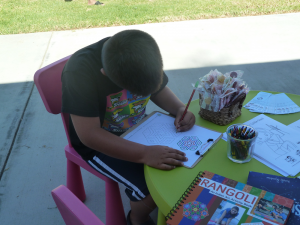
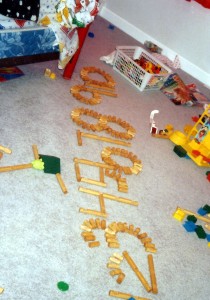





Pingback: The Gift of Three-Dimensionality We Call Dyslexia | The Right Side of Normal
Pingback: Comparing Apples to Oranges | The Right Side of Normal
Pingback: Your Child Might Be Right-Brained If … | The Right Side of Normal